How to prune a crape myrtle
Guest post by Allen Owings, senior horticulturist at Bracy’s Nursery, a wholesale nursery in Louisiana. This article appeared on Bracy’s Nursery’s Facebook page and is republished here (with light editing) with permission.
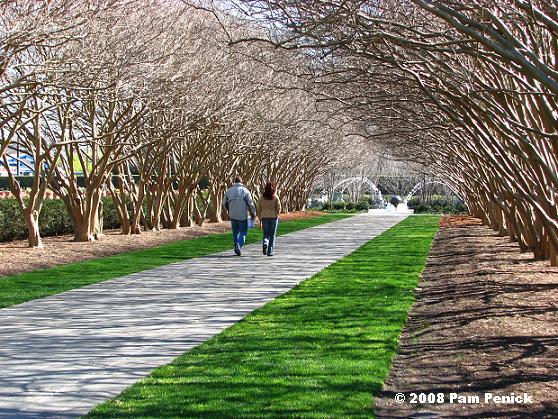
Crape myrtles are among the most abused and improperly pruned trees in residential and commercial landscapes throughout the South. Crape myrtles need only occasional pruning, best done mid- to late November through mid-February, to obtain the desired landscape effect. But many times these plants are butchered for no good reason.
An unfortunate trend in crape myrtle pruning is to lop off the tops of the trees, which results in a crew-cut appearance. The lush growth that occurs the following spring at these cuts appears vigorous, but it’s structurally weak and more susceptible to fungal diseases such as powdery mildew. Worse yet, when such pruning is done over several years, large, swollen, unsightly knobs form where the branches are topped. This creates an entry point for fungus, causing stem decay.
Crape murder – don’t do it
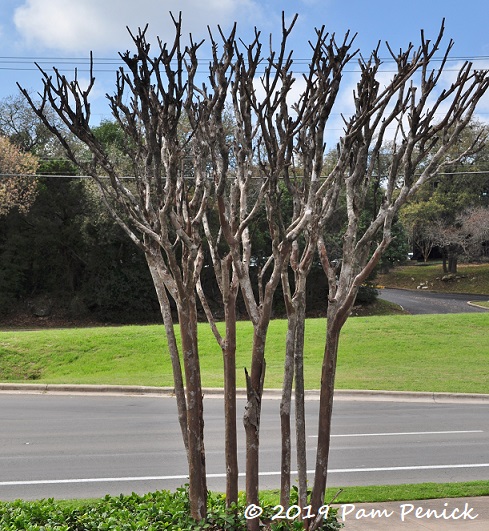
Some folks refer to this pruning method as crape murder. Crape murder does not actually kill a crape myrtle. But why are these popular flowering trees pruned this way?
The practice of cutting back the main branches of a tree to the same spot every year is called pollarding. This pruning method is used on some types of trees in certain situations, but it’s more common in Europe than America. You should understand that the life of a crape myrtle is shortened and the natural beauty of the tree is destroyed by this pruning technique. If this is understood, and you decide to pollard anyway, well, that’s your choice.
Many home gardeners think they are supposed to prune their crape myrtles that way. Nothing could be further from the truth. Some have been told that crape myrtles need to be topped to make them bloom better. This is not accurate. Flower clusters may be larger on crape-murdered trees, but the added weight on the ends of long, thin, new-growth branches causes them to droop awkwardly, especially after a rain. And because the tree is smaller, it produces fewer flower clusters.
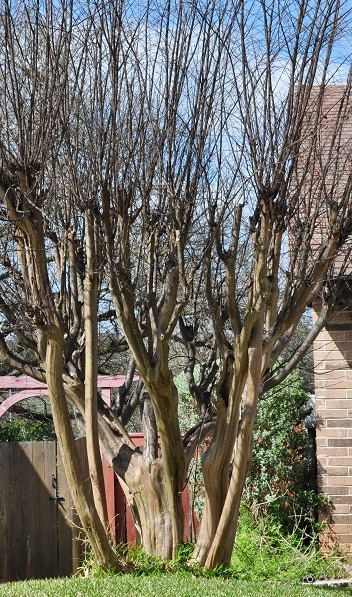
Can you prune to make a tree smaller?
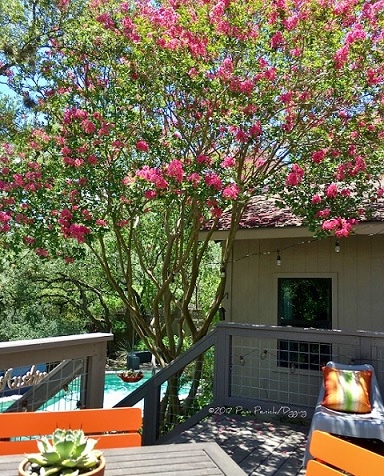
Sometimes crape myrtles are pruned improperly to create a different shape. A wide variety of crape myrtle varieties are available today. Some grow tall and upright like a vase, while others are shorter and spreading, having more of an umbrella or cascading effect. You cannot make an upright-growing crape myrtle grow into other shapes by cutting it back. The new growth will simply grow upright again. So if you want a crape myrtle that will mature in the shape you desire, make sure you choose one that naturally grows that way.
Sometimes crape myrtles are cut back because they are too large for the location where they were planted. This is commonly seen in crape myrtles planted close to a building. Instead of choosing a smaller-growing variety that would fit next to a house, a homeowner may plant a larger type that then grows into the gutter and roof. To salvage the situation, the owner begins cutting their tree back every year, ruining the natural beauty of the tree in the process.
Choose based on mature size, not just color
Even if you like the result, pruning every year is work that can be avoided by planting the right plant in the right place. For instance, if you want a white-flowering crape myrtle at the corner of your house, select ‘Acoma’, which matures at 10 to 12 feet, rather than ‘Natchez’, which matures at 25 to 30 feet.
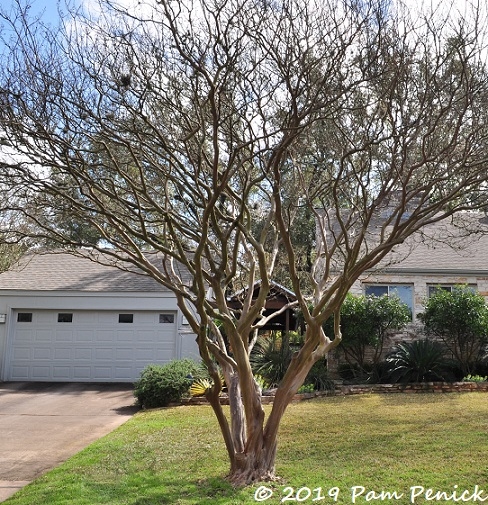
When and what to prune
With any pruning project, you must have a specific purpose in mind before you begin. If you can’t come up with a good reason to prune your tree, leave it alone. If you do see something that calls for pruning, study the tree carefully and determine what needs to be pruned to accomplish the specific purpose you’ve identified. Use “art and science” in pruning crape myrtles.
Appropriate reasons for pruning include eliminating branches that are crossed and/or rubbing against each other, removing low branches, removing weak and thin branches from the inner part of the tree, trimming off old seedpods, creating a more shapely tree, and removing suckers (shoots sprouting from the base of the trunk). Avoid cutting back or shortening branches larger than your finger. If you must cut one, prune it back to a side branch or to the trunk.
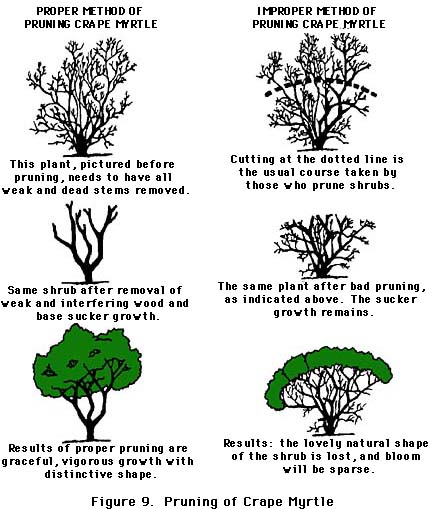
Proper pruning for happy trees
When you prune only to enhance a crape myrtle’s natural shape, rather than topping it, your tree will have:
- Stronger wood
- More flowers
- Larger flowers
- More pollinating insects
- Enhanced bark features
- Fewer watersprouts (vertical shoots from a trunk or branch)
- Fewer suckers
- More birds nesting
- Less fungal decay in wood
- Fewer insects that cause sooty mold
- Less leaf spot disease
- More air circulation in the canopy
With its smooth, muscular trunks, peeling bark, structure of leafless branches in winter, and exceptionally long blooming season in summer, the crape myrtle is rightfully popular. Make sure you keep yours looking its best.
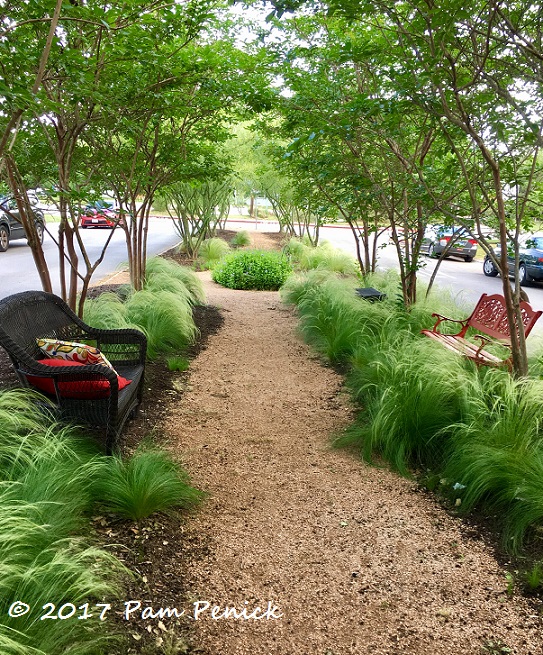
__________________________
My thanks to Allen Owings and Bracy’s Nursery for sharing their expertise about pruning one of our most beautiful yet mistreated trees here in the South. Crape pruning has been on my mind since I shared, last week on Facebook, an exasperated plea by Texas horticulturist Greg Grant for people to stop committing crape murder. (I can no longer find that link.) Given my approval of his message, I was surprised when a couple of commenters expressed their own frustration in return about not ever hearing from experts exactly how to prune a crape myrtle. I hope this post provides helpful information in that regard. –Pam
__________________________
Digging Deeper
Come learn about gardening and design at Garden Spark! I organize in-person talks by inspiring designers, landscape architects, authors, and gardeners a few times a year in Austin. These are limited-attendance events that sell out quickly, so join the Garden Spark email list to be notified in advance; simply click this link and ask to be added. Season 8 kicks off in fall 2024. Stay tuned for more info!
All material © 2025 by Pam Penick for Digging. Unauthorized reproduction prohibited.


The healthy, beautiful crape myrtles in Colleen Jamison’s median garden are the perfect poster children for proper pruning, and I was hoping to see them here. The Dallas Arboretum allee is perfection, but a little intimidating for the home gardener…
The latest version of the USDA winter hardiness zone map has ooched my county into zone 7 from 6b, and in town that’s probably true; certainly there are more surviving crape myrtles than you’d have seen a few decades ago. Blessedly, some of those in the most high-traffic spots are also outstanding examples of the right approach to pruning, with showy winter bark and plentiful summer bloom. (And natural root flares rather than buried in mulch, the other big factor in tree health that you’ve recently highlighted.)
Ha! Well, botanical gardens are aspirational, for sure. The Arboretum shows what mature, beautifully pruned crape myrtles can look like. And Colleen’s much newer crape allee shows how lovely they are even when trees are young.
I’m really glad to hear that crape myrtles in your town’s public spaces are pruned well. A maintenance victory! I fervently hope it continues.
Hi Pam,
What’s the name of the grass in the image taken in Colleen Jamieson’s garden, please?
Andrea
Hi Andrea! It’s Mexican feathergrass (Nassella tenuissima), a Texas native.
Well. My poor crepe myrtle has had crew cuts quite a few years and then I realized it was ruined and looked ugly and I stopped but too late. Now I don’t let anyone do anything to it. Poor baby.
Rose, crape myrtles are resilient. You can cut yours to the ground and start over if you’d like to have a beautiful tree again. It’ll send up new shoots from the roots this spring, and you can select 5 to 7 strong ones to let grow up into new trunks. Keep non-selected shoots pruned back to the roots. And then as your tree grows taller, just use a light hand when shaping it — and no crew cuts. 🙂 For another perspective that’s less drastic than cutting to the ground, Southern Living garden editor Steve Bender has a video tutorial on removing the “knuckles” from a bad pruning job and getting your crape back in shape again.
I have 3 miniature Crape Myrtles and they were damaged three years ago when we had some winds and now they grow really crooked almost laying back on the ground when they branch out. I am thinking that I need to trim them all the way back but my husband said they will straighten up but that is not happening. I even thought about replanting them. Help.
My first thought was that you should dig those puppies up and reposition them, especially since they are miniature crapes and presumably not too large. A quick Google search confirms that this is the best course of action. I would do it asap, while trees are still dormant. http://www.walterreeves.com/landscaping/tree-straightening-when-blown-over/
Hi Pam! Helpful diagrams, thank you. I’ve never pruned mine, but will look at the thinning-out of the weaker branches next year–too late for this year.
Planting a tree where it will have room enough when mature is probably the very best tactic of all.
Yes, and yet surprisingly difficult. It can be hard to visualize a tree’s mature size in relation to other trees, the house, etc.
Neat. I never knew this plant even bloomed. We use this to grow hiking sticks 🙂 so … each couple of years all the sticks get cut off and i let it grow new. Awesome plant in my book.
I…don’t even know what to say about this, Jeremy. Crape myrtle is ubiquitous throughout the South for its nonstop summer flowers. Are you pulling my leg? 🙂